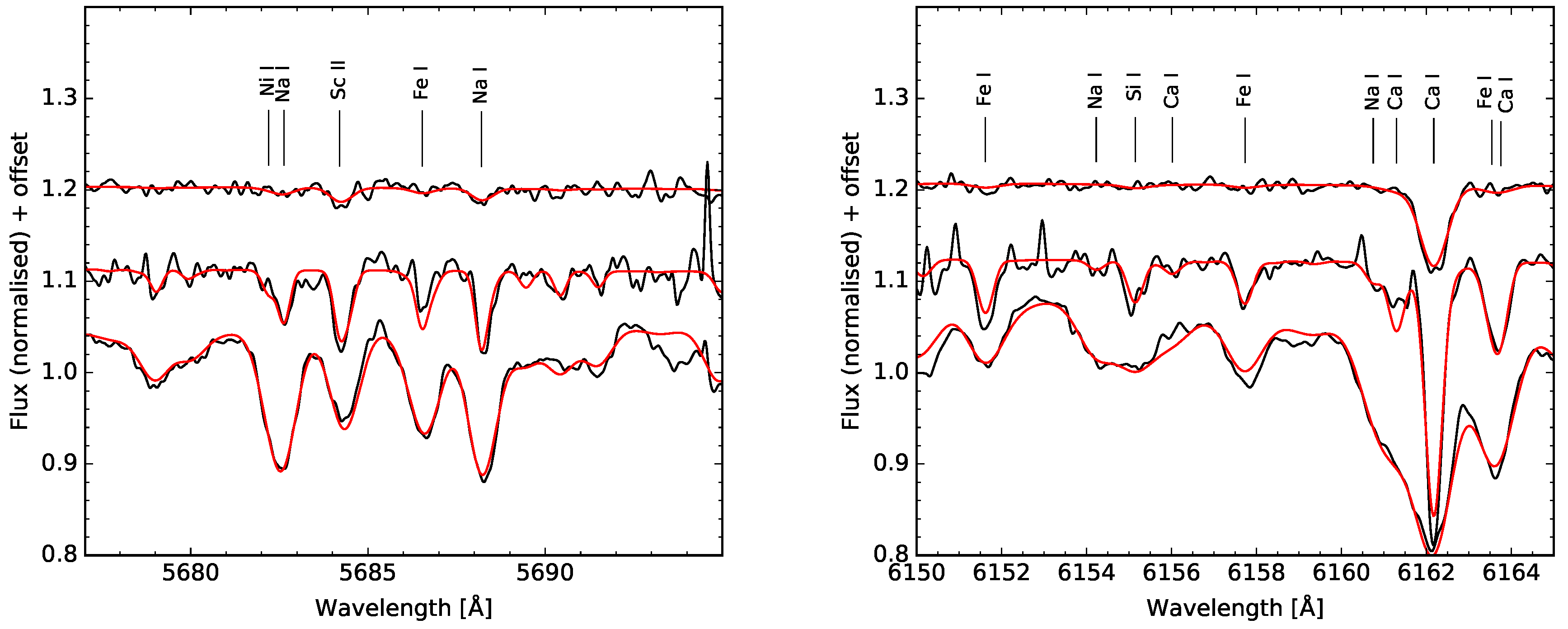Globular Clusters and the Halos of Dwarf Galaxies
Abstract
:1. Introduction
2. Globular Clusters in Dwarf Galaxies: Implications for Cluster Disruption
3. Chemical Abundances of GCs in Dwarf Galaxies
4. Conclusions
Conflicts of Interest
References
- Georgiev, I.Y.; Puzia, T.H.; Goudfrooij, P.; Hilker, M. Globular cluster systems in nearby dwarf galaxies—III. Formation efficiencies of old globular clusters. Mon. Not. R. Astron. Soc. 2010, 406, 1967–1984. [Google Scholar] [CrossRef]
- Harris, W.E.; Harris, G.L.H.; Alessi, M. A catalog of globular cluster systems: What determines the size of a galaxy’s globular cluster population? Astrophys. J. 2013, 772, 82. [Google Scholar] [CrossRef]
- Miller, B.W.; Lotz, J.M. The globular cluster luminosity function and specific frequency in dwarf elliptical galaxies. Astrophys. J. 2007, 670, 1074–1089. [Google Scholar] [CrossRef]
- Spitler, L.R.; Forbes, D.A. A new method for estimating dark matter halo masses using globular cluster systems. Mon. Not. R. Astron. Soc. 2009, 398, L1–L5. [Google Scholar] [CrossRef]
- Mieske, S.; Kuepper, A.; Brockamp, M. How tidal erosion has shaped the relation between globular cluster specific frequency and galaxy luminosity. Astron. Astrophys. 2014, 565, L6. [Google Scholar] [CrossRef]
- Larsen, S.S.; Strader, J.; Brodie, J.P. Constraints on mass loss and self-enrichment scenarios for the globular clusters of the Fornax dSph. Astron. Astrophys. 2012, 544, L14. [Google Scholar] [CrossRef]
- Larsen, S.S.; Brodie, J.P.; Forbes, D.A.; Strader, J. Chemical composition and constraints on mass loss for globular clusters in dwarf galaxies: WLM and IKN. Astron. Astrophys. 2014, 565, 16. [Google Scholar] [CrossRef]
- Bekki, K. Secondary star formation within massive star clusters: Origin of multiple stellar populations in globular clusters. Mon. Not. R. Astron. Soc. 2011, 412, 2241–2259. [Google Scholar] [CrossRef]
- D’Ercole, A.; Vesperini, E.; D’Antona, E.; McMillan, S.L.W.; Recchi, S. Formation and dynamical evolution of multiple stellar generations in globular clusters. Mon. Not. R. Astron. Soc. 2008, 391, 825–843. [Google Scholar] [CrossRef]
- Schaerer, D.; Charbonnel, C. A new perspective on globular clusters, their initial mass function and their contribution to the stellar halo and the cosmic reionization. Mon. Not. R. Astron. Soc. 2011, 413, 2297–2304. [Google Scholar] [CrossRef]
- Fall, S.M.; Zhang, Q. Dynamical Evolution of the Mass Function of Globular Star Clusters. Astrophys. J. 2001, 561, 751–765. [Google Scholar] [CrossRef]
- Jordán, A.; McLaughlin, D.E.; Côté, P.; Ferrarese, L.; Peng, E.W.; Mei, S.; Villegas, D.; Merritt, D.; Tonry, J.L.; West, M.J. The ACS Virgo Cluster Survey. XII. The Luminosity Function of Globular Clusters in Early-Type Galaxies. Astrophys. J. Suppl. Ser. 2007, 171, 101–145. [Google Scholar] [CrossRef]
- Kruijssen, J.M.D.; Portegies Zwart, S.F. On the interpretation of the globular cluster luminosity function. Astrophys. J. 2009, 698, L158–L162. [Google Scholar] [CrossRef]
- Vesperini, E. Evolution of globular cluster systems in elliptical galaxies. II. Power-law initial mass function. Mon. Not. R. Astron. Soc. 2000, 322, 247–256. [Google Scholar] [CrossRef]
- O’Connell, R.W.; Gallagher, J.S., III; Hunter, D.A. Hubble Space Telescope imaging of super-star clusters in NGC 1569 and NGC 1705. Astrophys. J. 1994, 433, 65–79. [Google Scholar] [CrossRef]
- Kurucz, R.L. ATLAS12, SYNTHE, ATLAS9, WIDTH9, et cetera. Mem. Soc. Astron. Ital. Suppl. 2005, 8, 14. [Google Scholar]
- Sbordone, L.; Bonifacio, P.; Castelli, F.; Kurucz, R.L. ATLAS and SYNTHE under Linux. Mem. Soc. Astron. Ital. Suppl. 2004, 5, 93. [Google Scholar]
- Alvarez, R.; Plez, B. Near-infrared narrow-band photometry of M-giant and Mira stars: Models meet observations. Astron. Astrophys. 1998, 330, 1109–1119. [Google Scholar]
- Gustafsson, B.; Edvardsson, B.; Eriksson, K.; Jørgensen, U.J.; Nordlund, Å.; Plez, B. A grid of MARCS model atmospheres for late-type stars. Astron. Astrophys. 2008, 486, 951–970. [Google Scholar] [CrossRef]
- Plez, B. TurboSpectrum: Code for Spectral Synthesis. Available online: http://ascl.net/1205.004 (accessed on 11 August 2017 ).
- Larsen, S.S.; Brodie, J.P.; Strader, J. Detailed abundances from integrated-light spectroscopy: Milky Way globular clusters. Astron. Astrophys. 2017, 601, A96. [Google Scholar] [CrossRef]
- Larsen, S.S.; Brodie, J.P.; Strader, J. Detailed abundance analysis from integrated high-dispersion spectroscopy: Globular clusters in the Fornax dwarf spheroidal. Astron. Astrophys. 2012, 546, A53. [Google Scholar] [CrossRef]
- Colucci, J.E.; Bernstein, R.A.; Cohen, J.G. The detailed chemical properties of M31 star clusters. I. Fe, alpha and light elements. Astrophys. J. 2014, 797, 116. [Google Scholar] [CrossRef]
- Sakari, C.M.; Venn, K.A.; Mackey, D.; Shetrone, M.D.; Dotter, A.; Ferguson, A.M.N.; Huxor, A. Integrated light chemical tagging analyses of seven M31 outer halo globular clusters from the Pan-Andromeda Archaeological Survey. Mon. Not. R. Astron. Soc. 2015, 448, 1314–1334. [Google Scholar] [CrossRef]
- Tolstoy, E.; Hill, V.; Tosi, M. Star-Formation Histories, Abundances, and Kinematics of Dwarf Galaxies in the Local Group. Ann. Rev. Astron. Astrophys. 2009, 47, 371–425. [Google Scholar] [CrossRef]
- Larsen, S.S.; Brodie, J.P.; Wasserman, A.; Strader, J. Detailed abundance analysis of globular clusters in the Local Group. NGC 147, NGC 6822, and Messier 33. 2017; in prep. [Google Scholar]
- Villanova, S.; Geisler, D.; Carraro, G.; Moni Bidin, C.; Muñoz, C. Ruprecht 106: The first single population Globular Cluster? Astrophys. J. 2013, 778, 186. [Google Scholar] [CrossRef]
- Hernandez, S.; Larsen, S.; Trager, S.; Groot, P.; Kaper, L. Chemical Abundances of Two Extragalactic Young Massive Clusters. Astron. Astrophys. 2017, in press. [Google Scholar] [CrossRef]

© 2017 by the author. Licensee MDPI, Basel, Switzerland. This article is an open access article distributed under the terms and conditions of the Creative Commons Attribution (CC BY) license (http://creativecommons.org/licenses/by/4.0/).
Share and Cite
Larsen, S.S. Globular Clusters and the Halos of Dwarf Galaxies. Galaxies 2017, 5, 46. https://doi.org/10.3390/galaxies5030046
Larsen SS. Globular Clusters and the Halos of Dwarf Galaxies. Galaxies. 2017; 5(3):46. https://doi.org/10.3390/galaxies5030046
Chicago/Turabian StyleLarsen, Søren S. 2017. "Globular Clusters and the Halos of Dwarf Galaxies" Galaxies 5, no. 3: 46. https://doi.org/10.3390/galaxies5030046





